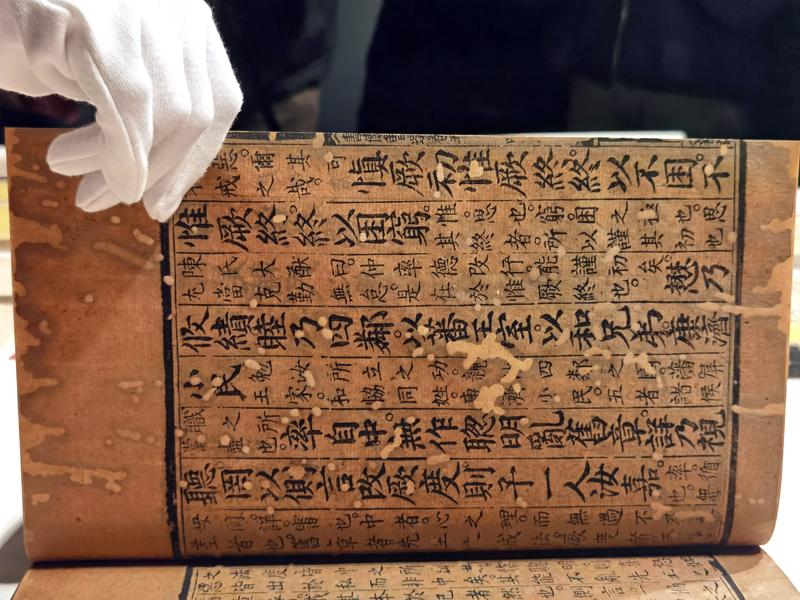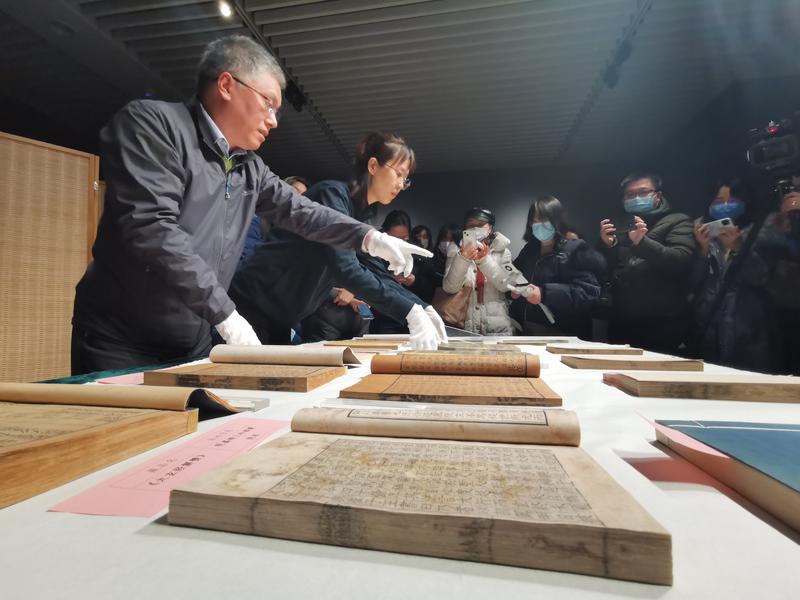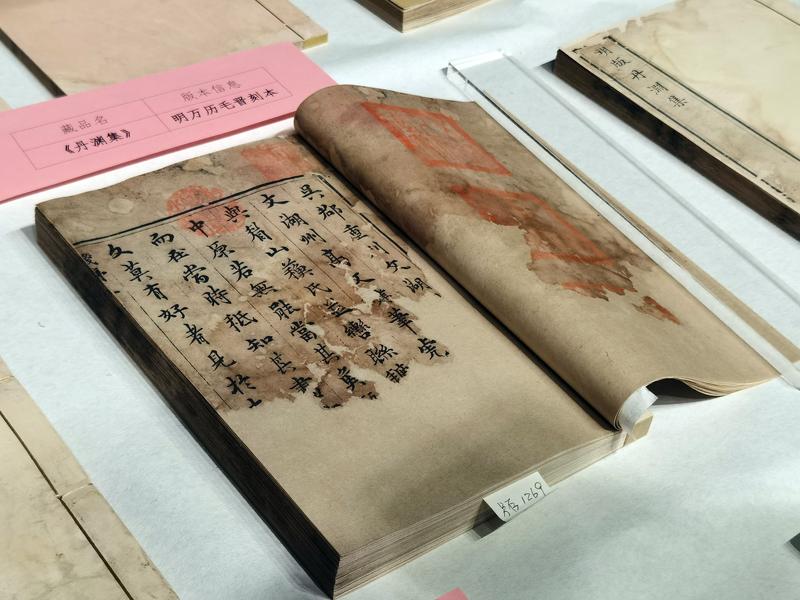The restoration of a vast ancient book collection, hailed as a milestone in literature conservation, is helping to inject new blood into the field, Wang Kaihao reports.
 A newly restored Ming Dynasty book, from the Tianlu Linlang collection, upon which blemishes caused by bookworms are recognizable. (WANG KAIHAO / CHINA DAILY)
A newly restored Ming Dynasty book, from the Tianlu Linlang collection, upon which blemishes caused by bookworms are recognizable. (WANG KAIHAO / CHINA DAILY)
For eight years, Cui Zhibin concentrated on these ancient pages. She had been looking for every possible way to prolong their lives, once fragile and even on the verge of being, literally, torn apart by time.
As a restorer of ancient books at the National Library of China in Beijing, the 35-year-old gets emotional when recalling the almost 3,000 days she spent fixing Tianlu Linlang, a precious literary collection, including 600-odd volumes of ancient books, which were once in the former inventory of a Qing Dynasty (1644-1911) royal study.
Stories of Tianlu Linlang reflect the change of a nation’s fate. So the physical restoration bears bigger significance to show a duty toward our culture and history.
Zhang Zhiqing, deputy director, National Center for Preservation and Conservation of Ancient Books
"This project will remain an important part of my career," Cui says. "It will always be a key component of my life, too."
Thanks to the efforts of Cui and her colleagues, on Jan 7, it was announced that the restoration of Tianlu Linlang was completed in the end of 2021-news that was widely hailed in the industry of ancient Chinese book restoration as a milestone.
"The most challenging part was that we had to draft a tailored plan for each copy, considering that their sizes, colors and materials vary greatly and their ages span centuries," Cui recalls.
Compared with more renowned tomes in China, such as the Dunhuang manuscripts dating to the Tang Dynasty (618-907), which were found in one of the Mogao Caves in Gansu province, and Yongle Dadian from the Ming Dynasty (1368-1644), the world's largest paper-based encyclopedia, Tianlu Linlang is not among the best-known ancient books that were restored by the national library in recent years.
Nevertheless, Zhu Zhenbin, who has worked at the National Library of China for over 40 years as the leading restorer of Tianlu Linlang, agrees the newly finished project was a greater challenge.
"Most ancient tomes, like the Dunhuang manuscripts and Yongle Dadian, were written within the same period of history, sharing similar format and paper," Zhu explains. "Once you make a restoration plan, it can work for every volume."
But due to the ambitious book collection plan of a Qing Dynasty emperor, the situation of Tianlu Linlang got complicated.
 Zhu Zhenbin (left) and Cui Zhibin, two restorers of Tianlu Linlang, display highlights from the restored volumes for the media at the National Library of China on Jan 7. (WANG KAIHAO / CHINA DAILY)
Zhu Zhenbin (left) and Cui Zhibin, two restorers of Tianlu Linlang, display highlights from the restored volumes for the media at the National Library of China on Jan 7. (WANG KAIHAO / CHINA DAILY)
Historical collection
Tianlu was the name of a royal library during the Han Dynasty (206 BC-AD 220)-often considered as the earliest national library in China-and linlang means "various precious jades" in Chinese. By choosing this title, Emperor Qianlong (1711-99) tried to pay homage to history and traditional culture.
The antique enthusiast's dream came true-664 volumes of, what he considered to be, the finest ancient books, ranging from the Song (960-1279) to Ming (1368-1644) dynasties, were chosen from studies in the Forbidden City, the imperial palace known as the Palace Museum today.
The emperor inked special seals on the first and last pages of each volume of these beloved treasures and carefully housed them in a study next to the Palace of Heavenly Purity, a key office and ceremonial hall for Qing emperors.
The different origins of these books mean that their formats and materials vary dramatically, and there are also marks of previous restorations from the late Qing Dynasty. Sometimes even three kinds of paper can be found in one book.
"Some books were made with bamboo paper, but paper made from bark or grass was also used, as were silk pieces, making some volumes particularly precious," Cui says.
"It's often impossible to find the identical material with which to restore the books, because the production techniques of the originals have been lost," she adds. "We can, therefore, only attempt to make the closest possible alternatives ourselves."
 Cui at work during the restoration project in 2017. (JIANG DONG / CHINA DAILY)
Cui at work during the restoration project in 2017. (JIANG DONG / CHINA DAILY)
To avoid any further damage to the relics, even the glues used in the restoration had to be handmade from raw flour.
"We can buy wheat starch, and it would be easier to use it to make glue," Cui says. "But we chose not to, fearing that food additives could lead to problems."
As Cui recalls, some volumes felt like crispy pastry in her hands. "They would crumble and fall apart once I touched them," she says.
Some books looked like hard bricks, with the pages all stuck together, while pages in other books felt like loose cotton because the fibers were so old.
With various handmade tools, and employing traditional craftsmanship and patience in equal measure, restorers finally ensured the safety of the pages.
The restoration experts need to be versatile in many skills. They are like chefs when they have to steam the books with precise timing and like gardeners when spraying water in the air to create the ideal moisture-rich environment for the cured pages.
It sometimes took a few hours to fix a single page, but it would not be unusual for some severely damaged pages to require days, or even weeks, of restoration work.
"After being repaired, we're confident that the pages can now survive at least another 200 years," Zhu says.
 A Ming Dynasty book in the Tianlu Linlang collection is displayed after restoration, with the seals of Emperor Qianlong on its first page. (WANG KAIHAO / CHINA DAILY)
A Ming Dynasty book in the Tianlu Linlang collection is displayed after restoration, with the seals of Emperor Qianlong on its first page. (WANG KAIHAO / CHINA DAILY)
Treasure hunt
A cautious and responsible attitude is necessary to complete such a high-profile restoration project of an ancient book-the largest in scale since the establishment of the National Center for Preservation and Conservation of Ancient Books, headquartered at the National Library of China, in 2007.
Regardless of its glory during Qianlong's era, the destiny of Tianlu Linlang was not so glamorous.
In the final years of the Qing Dynasty, some volumes were "lost" when they were taken to be repaired beyond the red walls of the Forbidden City.
After the Qing Dynasty government fell, the last emperor Puyi continued to live in the Forbidden City until 1924. During this time, he also transferred more volumes out of the palace as "gifts bestowed to others".
It was later discovered that the last emperor had kept the books in a warehouse, without protective measures, in Changchun, Jilin province, from 1931-45 when he ruled "Manchukuo" in Northeast China, a puppet state controlled by Japan. Some of the books were lost again when his "throne" fell once more.
In the 1930s, about 300 volumes that were still in the Palace Museum were moved first to East China and then to West China when the front line of the War of Resistance Against Japanese Aggression (1931-45) approached Beijing. They were supposed to return to their home after the invaders were defeated, however, in the aftermath of the following civil war, they were taken to Taipei, and have remained there.
Today, 279 volumes of Tianlu Linlang, or 3,500 copies, are housed in the national library. These cultural treasures were transferred from the Palace Museum to the library in the 1950s.
About 40 volumes are housed in Liaoning Provincial Library in Northeast China. Some others are in the hands of individual collectors, but the whereabouts of nearly 60 volumes are still unknown after the past century's upheavals.
"Stories of Tianlu Linlang reflect the change of a nation's fate," says Zhang Zhiqing, deputy director of the National Center for Preservation and Conservation of Ancient Books.
"So the physical restoration bears bigger significance to show a duty toward our culture and history," he says. "It can also provide reference for other conservators of this collection of ancient books."
According to an investigation by the National Library of China in 2013, over half of the Tianlu Linlang books in its collection were at least partially damaged-by water, worm, mold, mice or simply the passing of time-and 10 percent were in critical condition that urgently needed to be repaired.
Preparing for the restoration, librarians at the National Library of China also cataloged these books for the first time.
"Thanks to this project, we can rescue many precious treasures from the Song to Ming dynasties and thus contribute to academic studies," Chen Hongyan, deputy director of ancient books department of the library, says.
Many versions of print books from the Song Dynasty and the Yuan Dynasty (1271-1368) in Tianlu Linlang are incredibly rare.
"Some copies are the only surviving examples of their editions," Chen says. "You cannot exaggerate their value."
Chen reveals that the restoration was originally planned to be completed within five years, but difficulties were beyond expectation. Deadlines finally gave way to ensuring the safety of the pages.
"The project also helped us to nurture new understandings of what restoration should be like," Chen says.
 Some copies of Tianlu Linlang are severely damaged. PHOTO PROVIDED TO CHINA DAILY)
Some copies of Tianlu Linlang are severely damaged. PHOTO PROVIDED TO CHINA DAILY)
New chapter
Following her experienced tutor Zhu, Cui feels lucky to be allowed access to the literary treasure trove so soon after starting work at the National Library of China. For book restorers in the past, it would probably be unimaginable.
"An old-time master teaching book restoration wouldn't allow their apprentices to participate in major work until they had practiced a range of skills and done minor jobs for at least a decade," Zhu says.
"That time-consuming process was a good way to pass down the techniques, as authentic and completely as possible, from one generation to another," he continues. "But we're getting old and China severely lacks ancient book restorers. We couldn't afford to wait for so long."
Therefore, Zhu recruited fresh faces, like Cui, into his team. The earliest days were tough for the novice, but Zhu says the Tianlu Linlang project has proved that young restorers, who have a better educational background than their predecessors, can grow more quickly after honing their skills during the most important missions.
Cui and other young restorers from the National Library of China were not the only ones to take up the task. Under the framework of the National Center for Preservation and Conservation of Ancient Books, 12 restorers from key institutions nationwide, including Nanjing Library, Shanghai Library, and Shandong Library, were selected for the Tianlu Linlang project. Some graduate school students from the Chinese Academy of Social Sciences, majoring in ancient books, also took classes at the project's restoration site.
The entire working process was recorded in detail in videos for historical record.
"The restoration can greatly boost the perception of intangible cultural heritage nationwide, thanks to the participation of young people," Zhu says.
Restoration concerns more than tradition. In labs, modern scientific analysis of the abundant varieties of ancient paper in the volumes of Tianlu Linlang also helps to build a database that will efficiently help follow-up searches for the right material required for upcoming conservation projects.
"Human experience and traditional craftsmanship will never be entirely replaced, though," Zhu says.
Contrary to the public's general impression, ancient book restorers do not wear gloves when fixing the pages.
"Your skin has to nurture a feeling for paper and its patina," Zhu says. "That can only be gained through touch."
Not every restorer is excellent. In ancient times, restoration mostly relied on the experience of the restorer to choose the paper to fix the pages and decide how thick it should be, and, as a result, many errors were made.
"It poses a new question," Cui says. "A principle of our job demands that the restored relic should look just like the original, but what counts as 'original'? Its original situation when the book was first published? Or its appearance after being fixed by previous restorers?"
There was a debate on how the project should handle the marks of previous restorations. A consensus was finally reached: If the previous fixing method threatens the safety of the paper, it should be removed. Otherwise, it would be retained as a historical witness, even if it might not always be the best solution.
Cui understands her work is not to give the books an impeccable appearance, because their restoration is also part of history.
If some characters were already missing in the books, she will not fill them back in, nor will she clean all of the mildew spots on the yellowing pages.
She says:"I can wipe them out if I use chemical reagents, but what if people in the future find that I made the wrong decision?"
All restoration marks on Tianlu Linlang this time are "reversible".
"If future restorers have a better idea, they can go back and fix my work, or continue from where I left off," Cui says.
Contact the writer at wangkaihao@chinadaily.com.cn


